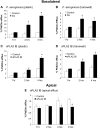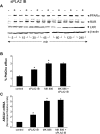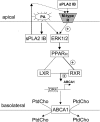Pseudomonas aeruginosa and sPLA2 IB stimulate ABCA1-mediated phospholipid efflux via ERK-activation of PPARalpha-RXR
- PMID: 17223797
- PMCID: PMC1876365
- DOI: 10.1042/BJ20061364
Pseudomonas aeruginosa and sPLA2 IB stimulate ABCA1-mediated phospholipid efflux via ERK-activation of PPARalpha-RXR
Abstract
Bacterial infection triggers an acute inflammatory response that might alter phospholipid metabolism. We have investigated the acute-phase response of murine lung epithelia to Pseudomonas aeruginosa infection. Ps. aeruginosa triggered secretion of the pro-inflammatory lipase, sPLA2 IB (phospholipase A2 IB), from lung epithelium. Ps. aeruginosa and sPLA2 IB each stimulated basolateral PtdCho (phosphatidylcholine) efflux in lung epithelial cells. Pre-treatment of cells with glyburide, an inhibitor of the lipid-export pump, ABCA1 (ATP-binding cassette transporter A1), attenuated Ps. aeruginosa and sPLA2 IB stimulation of PtdCho efflux. Effects of Ps. aeruginosa and sPLA2 IB were completely abolished in human Tangier disease fibroblasts, cells that harbour an ABCA1 genetic defect. Ps. aeruginosa and sPLA2 IB induced the heterodimeric receptors, PPARa (peroxisome-proliferator-activated receptor-a) and RXR (retinoid X receptor), factors known to modulate ABCA1 gene expression. Ps. aeruginosa and sPLA2 IB stimulation of PtdCho efflux was blocked with PD98059, a p44/42 kinase inhibitor. Transfection with MEK1 (mitogen-activated protein kinase/extracellular-signal-regulated kinase kinase 1), a kinase upstream of p44/42, increased PPARa and RXR expression co-ordinately with increased ABCA1 protein. These results suggest that pro-inflammatory effects of Ps. aeruginosa involve release of an sPLA2 of epithelial origin that, in part, via distinct signalling molecules, transactivates the ABCA1 gene, leading to export of phospholipid.
Figures











Similar articles
-
Phospholipase A2 group IIA correlates with circulating high-density lipoprotein cholesterol and modulates cholesterol efflux possibly through regulation of PPAR-γ/LXR-α/ABCA1 in macrophages.J Transl Med. 2021 Nov 27;19(1):484. doi: 10.1186/s12967-021-03151-3. J Transl Med. 2021. PMID: 34838043 Free PMC article.
-
Endocytosis is enhanced in Tangier fibroblasts: possible role of ATP-binding cassette protein A1 in endosomal vesicular transport.J Biol Chem. 2001 Oct 19;276(42):39476-83. doi: 10.1074/jbc.M105067200. Epub 2001 Aug 14. J Biol Chem. 2001. PMID: 11504722
-
Oxysterols trigger ABCA1-mediated basolateral surfactant efflux.Am J Respir Cell Mol Biol. 2004 Aug;31(2):227-33. doi: 10.1165/rcmb.2004-0038OC. Epub 2004 Mar 23. Am J Respir Cell Mol Biol. 2004. PMID: 15039140
-
[Functional analysis of phospholipase A2 receptor by gene knockout studies].Yakugaku Zasshi. 2001 Jan;121(1):23-33. doi: 10.1248/yakushi.121.23. Yakugaku Zasshi. 2001. PMID: 11201160 Review. Japanese.
-
ABCA1 and atherosclerosis.Vasc Med. 2005 May;10(2):109-19. doi: 10.1191/1358863x05vm593ra. Vasc Med. 2005. PMID: 16013195 Review.
Cited by
-
14-3-3zeta escorts CCTalpha for calcium-activated nuclear import in lung epithelia.FASEB J. 2010 Apr;24(4):1271-83. doi: 10.1096/fj.09-136044. Epub 2009 Dec 9. FASEB J. 2010. PMID: 20007511 Free PMC article.
-
Proteomic Biomarkers of Intrahepatic Cholestasis of Pregnancy.Reprod Sci. 2024 Jun;31(6):1573-1585. doi: 10.1007/s43032-023-01437-z. Epub 2024 Jan 4. Reprod Sci. 2024. PMID: 38177949 Free PMC article.
-
Ras/mitogen-activated protein kinase (MAPK) signaling modulates protein stability and cell surface expression of scavenger receptor SR-BI.J Biol Chem. 2011 Jul 1;286(26):23077-92. doi: 10.1074/jbc.M111.236398. Epub 2011 Apr 27. J Biol Chem. 2011. PMID: 21525007 Free PMC article.
-
Pseudomonas aeruginosa responds to exogenous polyunsaturated fatty acids (PUFAs) by modifying phospholipid composition, membrane permeability, and phenotypes associated with virulence.BMC Microbiol. 2018 Sep 14;18(1):117. doi: 10.1186/s12866-018-1259-8. BMC Microbiol. 2018. PMID: 30217149 Free PMC article.
-
Surfactant Lipids at the Host-Environment Interface. Metabolic Sensors, Suppressors, and Effectors of Inflammatory Lung Disease.Am J Respir Cell Mol Biol. 2016 May;54(5):624-35. doi: 10.1165/rcmb.2016-0011PS. Am J Respir Cell Mol Biol. 2016. PMID: 26859434 Free PMC article. Review.
References
-
- Hauser A. R., Cobb E., Bodi M., Mariscal D., Valles J., Engel J. N., Rello J. Type III protein secretion is associated with poor clinical outcomes in patients with ventilator-associated pneumonia caused by Pseudomonas aeruginosa. Crit. Care Med. 2002;30:521–528. - PubMed
-
- Arbibe L., Vial D., Rosinski-Chupin I., Havet N., Huerre M., Vargaftig B. B., Touqui L. Endotoxin induces expression of type II phospholipase A2 in macrophages during acute lung injury in guinea pigs: involvement of TNF-α in lipopolysaccharide-induced type II phospholipase A2 synthesis. J. Immunol. 1997;159:391–400. - PubMed
-
- Vial D., Senorale-Pose M., Havet N., Molio L., Vargaftig B. B., Touqui L. Expression of the type-II phospholipase A2 in alveolar macrophages: down-regulation by an inflammatory signal. J. Biol. Chem. 1995;270:17327–17332. - PubMed
Publication types
MeSH terms
Substances
Grants and funding
LinkOut - more resources
Full Text Sources
Miscellaneous

